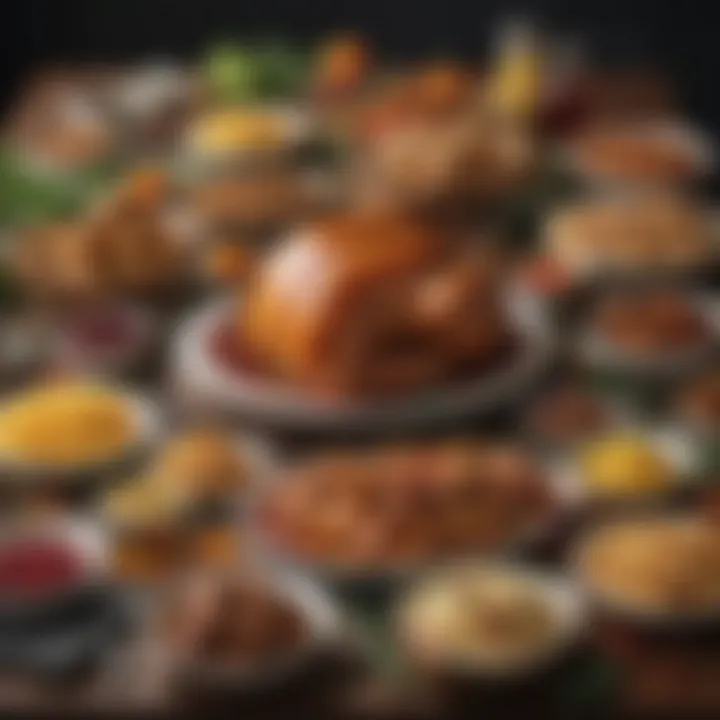Exploring Culinary Traditions of Holiday Meals


Intro
Holiday meals are more than just food on a table; they embody tradition, culture, and a hint of nostalgia. Sharing a meal during festivities often strengthens family ties and fosters community. Various cultures celebrate their significant days with unique culinary traditions rich in flavors and history. Whether it’s a hearty roast for Christmas in the West or a savory tamale feast for Día de los Muertos in Mexico, these meals reflect customs passed down through generations.
Yet, as society evolves, so do our palates and cooking practices. More individuals are exploring modern dietary needs and preferences while trying to hold onto the brands of flavor from their childhood. People often look to recreate the comfort of traditional holiday meals but may seek healthier options or vegetarian substitutes that align with their lifestyles.
This article aims to delve into the depths of holiday meals, detailing the essential dishes that have shaped various festive tables around the world. From the family favorite recipes that warm the heart to the innovative ways cooks today are adapting these meals, we will cover it all. By examining these culinary practices through the lens of both tradition and modernity, you’ll discover a rich tapestry of flavors that can easily find their place in your next celebration.
The Evolution of Holiday Meals
Understanding the evolution of holiday meals opens a window into how cultures adapt and thrive over generations. This exploration reveals not just what people eat during festive times, but also why those choices matter—tied to history, identity, and shared experiences. As dietary practices evolve alongside social dynamics, recognizing these shifts can offer deep insights into contemporary culinary practices.
Historical Context
The tale of holiday meals dates back in time, reflecting the broader human experience. From ancient harvest festivals to religious observances, meals have traditionally been at the core of celebrations. Consider, for example, the Roman Saturnalia, a festival marked by lavish feasts where social norms were upended, and slaves dined alongside their masters. The meals were more than sustenance; they symbolized a temporary suspension of the ordinary, a rich tapestry woven into the fabric of the society.
As we moved through history, the significance of holiday meals continued to evolve. In medieval Europe, the feast of Christmas often included a boar’s head, indicative of wealth and prosperity. In contrast, the Puritans established simpler, but meaningful traditions during their Thanksgiving—emphasizing community and gratitude over extravagance. Each cultural epoch brought its own flavors and customs, transforming how holidays were celebrated through food.
Cultural Variations
Culinary traditions surrounding holiday meals vary greatly across cultures, showcasing the diverse palate of human experience. In Mexico, the Día de los Muertos features offerings of pan de muerto—a sweet bread, often decorated with bone-like shapes, symbolizing the deceased. This meal isn't merely for consumption; it represents a dialogue with ancestors, highlighting the vital relationship between food, memory, and reverence.
On the other side of the globe, in India, festivals like Diwali incorporate elaborate sweets, like ladoo and barfi, prepared with the intent to share joy and merriment. Here, the holiday meal is a means of reconnecting with family and expressing hospitality, intertwining culinary practices with local customs and spirituality.
In stark contrast, during the Mid-Autumn Festival, the Chinese community celebrates with mooncakes—symbolizing reunion and harmony. Each culture, thus, negotiates its identity through festive meals, revealing deeper layers of communal bonds often expressed through shared dishes.
As modern society shifts—due to globalization, immigration, and hybrid cultures—the evolution of holiday meals showcases an ongoing dialogue. Traditional dishes often mingle with contemporary tastes, signaling a dynamic exchange where meals adapt, invent, and ultimately connect people across histories and geographies.
Food is not just fuel; it is a reflection of culture, heritage, and values, amalgamating traditions through generations.
Overall, the historical and cultural layers of holiday meals invite us into a shared journey—a celebration; reminding us that every dish has a story to tell, rooted in time and enriched by cultural exchanges.
Significance of Shared Meals
Shared meals hold a profound significance in the tapestry of human experience. They serve not only as nourishment but also foster connections between individuals, families, and communities. The act of gathering around a table is a ritual that transcends mere consumption; it embodies the essence of togetherness and presents an opportunity to cultivate relationships. During holiday seasons, when stress can run high, shared meals become a cornerstone of stability, promoting mindfulness and gratitude.
Family Bonds and Traditions
When speaking about family bonds, shared meals are perhaps the most time-honored tradition, played out in kitchens across the globe. Take the example of Thanksgiving in the United States, where families come together to share a meal featuring turkey, stuffing, and cranberry sauce. Each dish often carries a personal touch—Grandma’s secret recipe or a new addition from a family member experimenting in the kitchen. Families use these meals to not just savor food but to pass on stories, engage in laughter, and reinforce traditions unique to their lineage.
These gatherings present a moment to reflect on the past and acknowledge future generations. Children learn values of sharing, kindness, and cooperation as they help set the table or stir the pot. Similarly, in various cultures, holiday meals such as Diwali in India or Christmas in various Western countries underscore unity. During Diwali, families prepare a range of sweets and savory dishes, sharing them with neighbors, symbolizing the broader concept of community spirit.
Community and Festivity
Beyond household walls, Holiday meals often unite communities. Streets filled with colorful lights during the holiday season often lead to outdoor feasts and gatherings, making the festive spirit palpable. Think of the communal potluck where dishes from diverse cultures come together. Each plate holds a story, a heritage, and a connection to the broader community fabric.
In many cultures, festivals bring about large communal meals where everyone contributes something. For instance, the Mid-Autumn Festival in Chinese culture sees families and friends gather to enjoy mooncakes, symbolizing unity and the importance of family. By sharing their unique culinary creations, people draw closer, creating an atmosphere of sharing and celebration.
"Sharing a meal is a universal way to express love and hospitality, regardless of cultural differences."
Such gatherings not only satisfy hunger but also strengthen social bonds, creating a lasting impact that stretches beyond the holiday itself. They remind us of our shared humanity, encouraging collaboration and understanding within diverse cultural landscapes. In essence, shared meals during holidays are a celebration, a practice that reinforces relationships and builds community, ultimately contributing to a richer, more inclusive society.
Traditional Recipes Around the World
In the grand tapestry of culinary practices, traditional recipes form the vibrant threads that weave together culture, history, and identity. Each dish tells a story, often passed down through generations, carrying with it the weight of family's traditions and preferences. Acknowledging the importance of these recipes allows us to connect on a deeper level with the cultures that create them, ensuring that we do not lose sight of our rich nutritional heritage amid the fast-paced changes of modern life. Traditional recipes not only nourish the body but also foster a sense of community and belonging, making every bite a shared experience.
Familiar Dishes: An Overview
Familiar dishes are the foundation of holiday feasts across the globe. They resonate with significance and often evoke memories associated with past celebrations. Such recipes vary from the Mexican tamales, layered with flavors and filled with meats or cheeses, to the Italian panettone, a sweet bread enriched with dried fruits and a hint of zest that marks the festive season. These well-known articles of culinary delight often hold a special place at the table, serving as a comfort during family gatherings.
The charm of these dishes lies in their simplicity and the use of readily available ingredients. While the details may differ from one household to another, there’s often a sturdy framework that keeps the essence intact. For instance, many cultures prepare roast meats, with turkey and ham being quintessential staples in the United States, representing abundance and gratitude.
Regional Specialties


Regional specialties reflect the local produce and traditional cooking methods of a particular area. From the savory casseroles of the American Midwest to the spicy curries of South Asia, these meals embody the unique flavors of their origins. Here's a closer look:
- East Asia: The culinary tradition here often includes dishes like Peking Duck in China or Korea's Kimchi Jjigae. These recipes are perfectly spiced, preparing the palate for the season of celebration.
- Northern Europe: Countries like Sweden present Julbord, a buffet-style meal filled with herring, meats, and cheeses. In this context, the meal becomes more than food; it transforms into a way to honor the land and the sea.
- Latin America: Festive meals incorporate vibrant spices and local produce. The Argentine Asado, a gathering centered around grilling meats, brings family and friends together, lovingly showcasing the culinary traditions of the region.
- Middle East: Countries like Lebanon celebrate with dishes such as Mujadara, a comforting blend of lentils and rice, garnished with caramelized onions. It reflects the abundance of grains and generous hospitality that defines the area.
Understanding how these regional specialties shape holiday meals enlightens our appreciation of different cultures. Each dish offers a lens into the values and resources of a community, reminding us that food is not only about sustenance but also about the celebration of life and togetherness.
"A dish is a story, a recipe a heritage passed from one generation to the next. What flavors do your stories carry?"
In summation, the exploration of traditional recipes around the world reveals the diverse cultural practices that enrich our culinary landscape. Be it a familiar dish or a regional specialty, every meal is an expression of love, history, and artistry, making the holiday season even more special.
Modern Adaptations of Holiday Meals
In today’s fast-paced world, the framework of holiday meals is continuously evolving. This section sheds light on the importance of modern adaptations and how they reshape culinary traditions, allowing for inclusivity and greater innovation. With changing dietary preferences, cultural exchanges, and a growing awareness of health, modern adaptations are not just beneficial; they are essential to keeping the spirit of holiday meals alive and accessible to everyone.
There is a variety of factors driving these adaptations. Firstly, the significance of health-conscious choices cannot be overlooked. In this era, people are increasingly becoming aware of the ingredients they consume and the impact on their overall wellbeing. Secondly, with the rise in vegetarian and vegan diets, a wider array of options are making holiday meals more inclusive, keeping in mind the diverse dietary needs of family and friends. Lastly, the demand for gluten-free alternatives has surged as more individuals are diagnosed with gluten sensitivity. Therefore, each of these aspects adds a rich layer to the festive table, aligning with contemporary tastes and health considerations.
Health-Conscious Modifications
Making health-conscious modifications during the holiday season means rethinking traditional recipes and exploring alternative ingredients. Instead of hefty, calorie-laden dishes, many are swapping out refined sugars for natural sweeteners like honey or maple syrup. This simple change can transform a holiday treat into a guilt-free indulgence.
Here are some popular health-conscious adaptations:
- Reduced sodium content in savory dishes. salty flavors can often overwhelm palates. Using herbs and spices could instead enhance the meal’s profile without sacrificing taste.
- Incorporation of whole grains. Instead of white rice or pasta, options like quinoa or farro can add not only health benefits but also a nutty flavor and appealing texture.
- Substituting ingredients. Using Greek yogurt instead of sour cream or mayonnaise can cut calories while adding protein. You can also replace butter with olive oil for a heart-healthy twist.
"Healthier adaptations help us enjoy our favorite holiday meals without the stress of compromising our wellbeing."
These switches may seem minor, but they significantly impact the nutritional value of holiday meals, allowing everyone to enjoy the festivities while remaining mindful of their health.
Vegetarian and Vegan Options
With the growing popularity of plant-based diets, adapting traditional holiday meals to include vegetarian and vegan options has become a priority. What once might have been a table primarily populated with meat dishes can now be a vibrant collage of vegetables, legumes, and grains that celebrate the spirit of the season.
Some innovative ideas for vegetarian and vegan adaptations include:
- Stuffed Squash: A hollowed-out butternut squash filled with quinoa, nuts, and cranberries presents a vibrant alternative to turkey.
- Vegan ‘Meat’ Loaf: Made with lentils, mushrooms, and nuts. It's hearty and a crowd-pleaser, captivating even meat-eaters.
- Cashew Cream: Instead of traditional creamy dishes, using blended soaked cashews creates a rich and satisfying alternative that can replace heavy sauces.
These options not only cater to dietary restrictions but also showcase creativity. The seasonal bounty of vegetables can shine, creating hearty dishes that invite everyone to the table.
Gluten-Free Alternatives
As more people are becoming aware of gluten sensitivities, incorporating gluten-free alternatives into holiday meals is essential for inclusive dining. Whether it’s through adapting existing recipes or creating new ones from scratch, there are plenty of ways to ensure that gluten-free guests feel welcomed.
Here are a few strategies:
- Using gluten-free grains. Instead of traditional bread, consider serving gluten-free options like brown rice or barley, which lend a hearty feel to the meal.
- Alternative flours. Explore options like almond flour or coconut flour when baking treats. These can yield less dense results while being gluten-free.
- Diverse side dishes. Focus on naturally gluten-free items, like roasted vegetables, salads, or quinoa dishes. They not only diversify the meal but also ensure safe options for those with dietary restrictions.
In summary, modern adaptations of holiday meals play a crucial role in bringing people together, honoring traditions while accommodating health and personal choices. This not only enhances the culinary landscape but also fosters inclusivity, allowing everyone to partake in the joy of shared meals.
The Role of Cooking Techniques
Cooking techniques play a crucial role in shaping the experience of holiday meals. They transform simple ingredients into something extraordinary, enhancing flavors and textures while ensuring the dishes resonate with cultural significance. When it comes to the festive table, every cooking method carries weight, influencing not just the outcome on the plate, but also the emotional connections tied to shared meals.
Different cooking techniques can evoke nostalgia. Think of how home-baked breads or slow-roasted meats remind us of family gatherings or festive celebrations. With the right method, a seemingly plain vegetable can turn into a vibrant side dish that steals the show. This section delves into the significance of choosing the right cooking methods, providing insight into why they matter in the grand scheme of holiday planning.
Choosing the Right Cooking Method
Selecting the appropriate cooking method can make all the difference between a meal that sings and one that falls flat. Several factors influence this choice, including the ingredients' characteristics, desired flavors, and cultural traditions. Common techniques like baking, roasting, or braising can each impart unique qualities to a dish.
- Baking: Perfect for pies and breads, this technique harnesses dry heat in an oven. This results in a crusty exterior while keeping fillings moist, creating a delightful contrast.
- Roasting: Often used for meats and hearty vegetables, roasting enhances natural sweetness through caramelization, boosting flavors that can evoke warmth and comfort.
- Steaming: This technique retains nutrients and is excellent for vegetables. Steamed greens can maintain their color and vitality, allowing guests to feel good about their food choices.
Choosing the right method can elevate not just the dish, but the entire dining experience by reinforcing memories and traditions.
Ultimately, the right cooking method is like a reliable compass in the kitchen; it guides chefs toward flavors that bring joy and satisfaction.


Time-Saving Techniques
During the holidays, time is often a rare commodity. As families gather and festivities unfold, many find themselves juggling multiple tasks in the kitchen. To ensure a stress-free experience, incorporating time-saving techniques can ease the burden while maintaining culinary quality.
- Batch Cooking: Preparing large quantities of dishes ahead of time allows for effortless reheating when needed. Freezing soup or casseroles can be a lifesaver.
- Prepping Ingredients: Chopping, marinating, or measuring out key ingredients in advance allows for smooth sailing on the day of the meal. Nobody wants to be frantically chopping veggies while the turkey is in the oven.
- Utilizing Kitchen Gadgets: Consider using pressure cookers or slow cookers. They can cook meals while allowing you to do other tasks. Imagine setting a roast and letting it cook while you entertain guests!
Implementing strategies to save time doesn't just lighten the load; it allows space to enjoy the holidays as intended—surrounded by loved ones with a plate full of delicious offerings.
Planning and Preparation Strategies
Planning and preparation are at the heart of creating memorable holiday meals. When it comes to pulling off a festive feast, a strategic approach not only alleviates stress but also enhances the overall experience for both the cook and the guests. This section dives into the nuts and bolts of organizing kitchen activities, optimal ingredient selection, and efficient meal execution.
Meal Planning Essentials
At the core of successful holiday meal preparation is the act of meticulous meal planning. It involves considering everyone’s tastes, dietary needs, and even potential allergies. To craft a well-rounded menu, it’s important to balance flavors, textures, and cooking times. Let’s look at some key elements:
- Diversity of Dishes: Aim for a mix of appetizers, mains, sides, and desserts. A little something for everyone can go a long way in ensuring no one leaves the table hungry.
- Cultural Influences: Bringing in traditional dishes from various cuisines can also enrich the meal. For instance, a Thanksgiving spread could include both turkey and a flavorful biryani, fostering a delightful fusion.
- Timeline Creation: Writing down a clear timeline for each dish helps in managing cooking times effectively. Knowing when to start cooking each element allows for smoother operations.
Keep this meal planning checklist handy to avoid last-minute panics:
- List out the dishes.
- Estimate the time required for each.
- Make a note of serving sizes.
- Include any necessary prep work in advance.
Shopping for Ingredients
Once the meal plan is set, the next step is sourcing the ingredients. Shopping should be treated as an art—know your canvas (your menu) and choose your colors (ingredients) wisely. Here are some tactics to consider:
- Freshness Matters: Start with a visit to local farmers' markets or specialty stores. Fresh produce can make a world of difference in flavor and presentation.
- Quality over Quantity: It’s tempting to buy in bulk, but focusing on high-quality ingredients leads to better-tasting meals. For instance, sourcing prime cuts of meat or artisan cheeses can elevate the festive spread.
- Checklists and Baskets: Prepare a thorough shopping list to avoid impulse buys. Organizing items into categories (like vegetables, proteins, and pantry staples) streamlines the process and ensures you don’t miss anything essential.
Helpful resource: How to Plan a Shopping Trip
Setting Up the Kitchen
With groceries in hand, setting up your kitchen efficiently becomes critical. A well-organized kitchen allows for fluid movements and minimizes confusion. Start by decluttering the workspace. Here are some points to consider:
- Organization is Key: Arrange utensils, pots, and pans neatly. Keeping commonly used tools within arm's reach can save time when you're in the thick of preparation.
- Designate Work Zones: Create specific areas for chopping, cooking, and plating. Having dedicated spaces helps in maintaining focus and speeding up the process.
- Prep Ahead: Many components can be prepared in advance. Chopping veggies or pre-measuring spices not only saves time on the big day but also reduces the mess during cooking.
"A kitchen set up right makes the task at hand feel less overwhelming and more enjoyable."
By implementing these planning and preparation strategies, cooks can navigate the busy holiday season with confidence. Whether with family traditions or new culinary experiments, a well-prepared meal always leaves a lasting impression.
Crafting the Perfect Holiday Menu
Creating a holiday menu is more than just listing dishes; it’s about weaving together flavors, textures, and traditions to make an experience memorable. A well-thought-out menu highlights the essence of the occasion and brings loved ones together, celebrating both the food and the people enjoying it. The key to a perfect holiday menu lies in careful planning, an understanding of your guests' preferences, and a dash of creativity.
Balancing Flavors and Textures
A balanced holiday menu should offer a variety of flavors and textures. Think of it like putting together a puzzle – each piece must fit and complement the others. Here are some elements to consider:
- Sweet and Savory: Merging sweet dishes with savory ones creates a delightful contrast. For instance, maple-glazed carrots bring a touch of sweetness that pairs beautifully with roasted meats.
- Texture Variety: A menu should play with textures, mixing creamy, crispy, crunchy, and chewy foods. Imagine alongside a rich mashed potato, a crunchy Brussels sprout salad. The difference in texture keeps things interesting.
- Seasoning Levels: Be sure to adjust seasoning levels to keep dishes balanced. A dash of acidity from lemon or vinegar can brighten a heavy dish, making it easier to digest.
It’s also important to think about how these elements can add to the overall dining experience. A meal that flows from bright and zesty starters to richer mains captivates diners and gives them something to savor.
Incorporating Seasonal Ingredients
Using seasonal ingredients not only enhances flavor but also connects your meal to the time of year. Fresh, local produce is often at its peak during the holidays, inviting vibrant colors and robust flavors to your table. Here are some considerations:
- Local Fare: Shop at local farmers' markets or grocery stores to find ingredients that are currently in season. Whether it’s sweet potatoes in fall or fresh berries in spring, sourcing local produce supports the community and elevates your meal.
- Emphasizing Freshness: Seasonal ingredients like herbs, greens, or root vegetables tend to have more flavor and nutrients compared to out-of-season produce. Think of using fresh rosemary for roasted meats or vibrant kale for salads.
- Colorful Displays: Seasonal ingredients often bring color to your dishes, appealing to the eyes as much as the palate. A mix of deep greens, bright reds, and warm earthy tones can make any table inviting.
Incorporating seasonal ingredients doesn’t just make sense from a flavor perspective; it’s also about embracing the rhythms of nature. When planning your holiday menu, think about how these fresh ingredients can elevate each dish and reflect the essence of the season.
A perfect holiday menu is not just a list of dishes—it's an invitation to celebrate, connect, and enjoy every bite with the people we cherish.
By carefully crafting your holiday menu, keeping in mind the balance of flavors and the use of seasonal ingredients, you create a feast that resonates with meaning and joy. It allows every guest to be part of something larger than themselves, making the meal a celebration of culture, community, and tradition.


Serving and Presentation
The act of serving and presenting a holiday meal is more than just a functional aspect; it is a vital part of the dining experience. People eat with their eyes first, so how a dish is plated and how the table is arranged can significantly affect the overall enjoyment of the meal. Good presentation can elevate even the simplest recipes, making them seem more festive and special.
When planning for a holiday meal, consider how the layout of the table can foster a warm and inviting atmosphere. This includes not just the arrangement of dishes, but also the aesthetic appeal of the table setting—colors, textures, and even lighting come into play. For instance, a beautifully set table with a well-thought-out color scheme can transform the dining experience from routine to extraordinary.
In addition to aesthetics, practical considerations must be balanced with the desire for visual appeal. Ensuring that the dishes are easy to reach and serve, while maintaining the beauty of the setting, requires some creativity and foresight. Think about the flow of the meal and how guests will move around the table. Arranging dishes in a manner that allows for easy serving not only enhances the experience but also ensures that the meal can proceed smoothly.
"The beauty of a meal often lies in its presentation; it's about making a meal feel special, not just another plate of food."
Table Settings and Decor
A holiday meal's ambiance often begins with the table setting. It reflects the spirit of the occasion and sets the mood for gathering. While traditional settings often incorporate classic elements—such as white tablecloths and elegant dishware—contemporary style might delve into more eclectic and personal touches.
Consider these elements when setting the table:
- Table Linens: Layering different textures can add depth. A crisp linen tablecloth with colorful napkins can evoke a festive spirit.
- Centerpieces: Choose centerpieces that resonate with the theme of the holiday, whether that’s pinecones and candles for winter holidays or fresh flowers for spring celebrations. They should enhance the mood without obstructing the view across the table.
- Dinnerware and Glassware: Select dishes that coordinate with the holiday theme, whether they are formal china or rustic ceramic plates. Glassware should complement the meal, from wine glasses to sparkling water flutes.
- Lighting: Soft lighting creates a more inviting environment. Candles or strategically placed fairy lights can warm up the space.
Keeping your table uncluttered while highlighted with the right decorations will make all the difference.
Plating Techniques
Plating is both an art and a science, and mastering it can take your holiday meals to another level. A well-plated dish draws in the diner, prompting curiosity and excitement about what they are about to taste. Some fundamental techniques elevate the look of a meal, encouraging guests to indulge their senses.
- Layering: Different textures and colors attract the eye. For instance, thinly sliced roasted beetroot layered with creamy goat cheese creates a visual impact while offering a contrast in flavor and texture.
- Height: Elevating components on the plate can add drama. A tower of carefully assembled roasted vegetables can be more appealing than a flat presentation.
- Garnishes: Fresh herbs, edible flowers, or a sprinkle of flavorful microgreens can add that final touch. For example, a dash of finely chopped chives on a creamy potato dish not only looks appealing but also enhances flavor.
- Portion Control: Keeping portions neat and controlled ensures that the focus is not just on quantity but also on how each bite is savored.
Ultimately, presentation is about more than mere appearances. It’s the bridge that connects the food to the tradition and occasion, enhancing the experience of sharing a meal while fostering connections amongst family and friends.
Holiday Meal Challenges
Navigating the complex landscape of holiday meals can often feel like a high-wire act, requiring both skill and balance. The joy of gathering loved ones around a feast can quickly be overshadowed by the challenges that arise in planning and preparation. These challenges are paramount considerations that can dictate the overall success and enjoyment of the holiday experience. Understanding these hurdles not only helps in crafting delightful meals but also ensures that everyone at the table can partake in the festivities without a hitch.
Dealing with Dietary Restrictions
In today's world, food choices are as diverse as the people who make them. With more individuals becoming health-conscious or embracing various dietary lifestyles, adapting holiday meals to accommodate these needs is both essential and rewarding. Whether it's gluten intolerance, nut allergies, or a vegetarian lifestyle, hosts face the task of crafting a menu that is both inclusive and festive.
To tackle this, consider the following steps:
- Communicate Early: Reach out to guests before planning the menu. Understanding their specific dietary needs can help in crafting dishes that everyone will enjoy.
- Offer Variety: Include multiple dishes that cater to various diets. This might mean preparing a robust salad filled with seasonal veggies for the vegans at the table, while also offering a traditional meat-based option for others.
- Modify Traditional Dishes: Much of the traditional holiday fare can be innovated. For instance, swapping out regular flour for almond flour in your pie crust can create a gluten-free option without sacrificing taste.
"Accommodating dietary restrictions does not mean sacrificing flavor. With a touch of creativity, you can delight every palate at your table."
Managing Time Constraints
With the hustle and bustle that often accompanies the festive season, time becomes a great adversary for many home cooks. Balancing work, family engagements, and meal preparation can lead to a chaotic atmosphere both in and out of the kitchen. To master this challenge, here are a few strategies:
- Create a Timeline: Draft a clear timetable outlining when to shop, prepare, and cook each meal. This visual guide helps maintain focus and prevent last-minute scrambles.
- Prep Ahead: Whenever possible, prepare components in advance. Soups can be made the day before, and vegetables can be chopped ahead of time. Putting in this bit of extra effort can save you substantial time when the day arrives.
- Simplify When Necessary: Sometimes, less is more. A few well-prepared dishes that shine can be far more enjoyable and less stressful than an overstuffed table. Consider making a large pot of a flavorful stew paired with a hearty bread, which can be both filling and manageable.
In dealing with holiday meal challenges, flexibility and foresight can make a world of difference. By embracing dietary restrictions and carefully managing time constraints, you can ensure that your holiday meals are not only a joy to prepare but also a source of warmth and connection for all who gather around your table.
Feedback and Iteration
Feedback and iteration are invaluable parts of improving holiday meals. When we bring together family or friends for shared meals, we often want not just to fill stomachs but also to create lasting memories. Gathering insights from diners enables cooks to understand what works and what doesn't in terms of taste, presentation, and overall experience. It turns a simple dinner into a night to remember, and it builds on the flavors and customs that make holiday meals special. The art of cooking is evolving, and listening to constructive criticism can be the linchpin that prepares us for a more delightful experience at the next gathering.
Gathering Insights from Diners
When the plates empty and the laughter subsides, that’s the golden moment to ask for feedback. Engaging diners in discussions about what they thought of the meal can shed light on favorite dishes or new flavors they enjoyed. There are a few reasons why this step is crucial:
- Building Relationships: Encouraging open conversations around the table nurtures an atmosphere where everyone feels valued. When diners know their opinions matter, they’re more likely to share genuine feedback.
- Identifying Trends: Over time, recurring comments about specific flavors or dish presentations can highlight new trends in what’s appealing.
- Encouragement to Experiment: Positive feedback can serve as a springboard for trying out new recipes or flavors in the future. If diners rave about a dish, it boosts the cook's confidence and creativity.
Consider using informal methods for gathering insights, like a fun feedback card passed around after dinner. Alternatively, a simple chat while clearing the table can also do wonders. Asking specific questions, such as “Which dish do you think could use a little more spice?” or “What did you think about the dessert?” can yield productive responses.
Adjusting for Future Meals
Once you’ve gathered insights from your diners, it’s time to take a step back and reflect on how to use this feedback to adjust future meals. An iterative process allows you to refine your culinary craft step by step. Here are some considerations to keep in mind:
- Prioritize Feedback: Not all comments will be equally useful. Focus on consistent feedback from multiple diners, as this provides a clearer picture of what could be improved.
- Experiment: Don’t shy away from using the insights to try something new. For example, if multiple guests mention wanting spicier dishes, experiment with ingredients like cayenne pepper or fresh chilis in future meals.
- Document Changes: Maintaining a cooking diary or a digital note can be beneficial. Make a note of specific feedback and the adjustments you plan to try. This way you'll have a clear reference for what worked and what didn’t.
- Create a Signature Experience: Use the feedback to foster a unique dining experience that diners will look forward to annually. Maybe your roasted vegetables become renowned as crowd-pleasers or your cranberry sauce a holiday staple.
"Good food is all about the love and memories tied to it; use feedback to continually weave that love into every meal."







